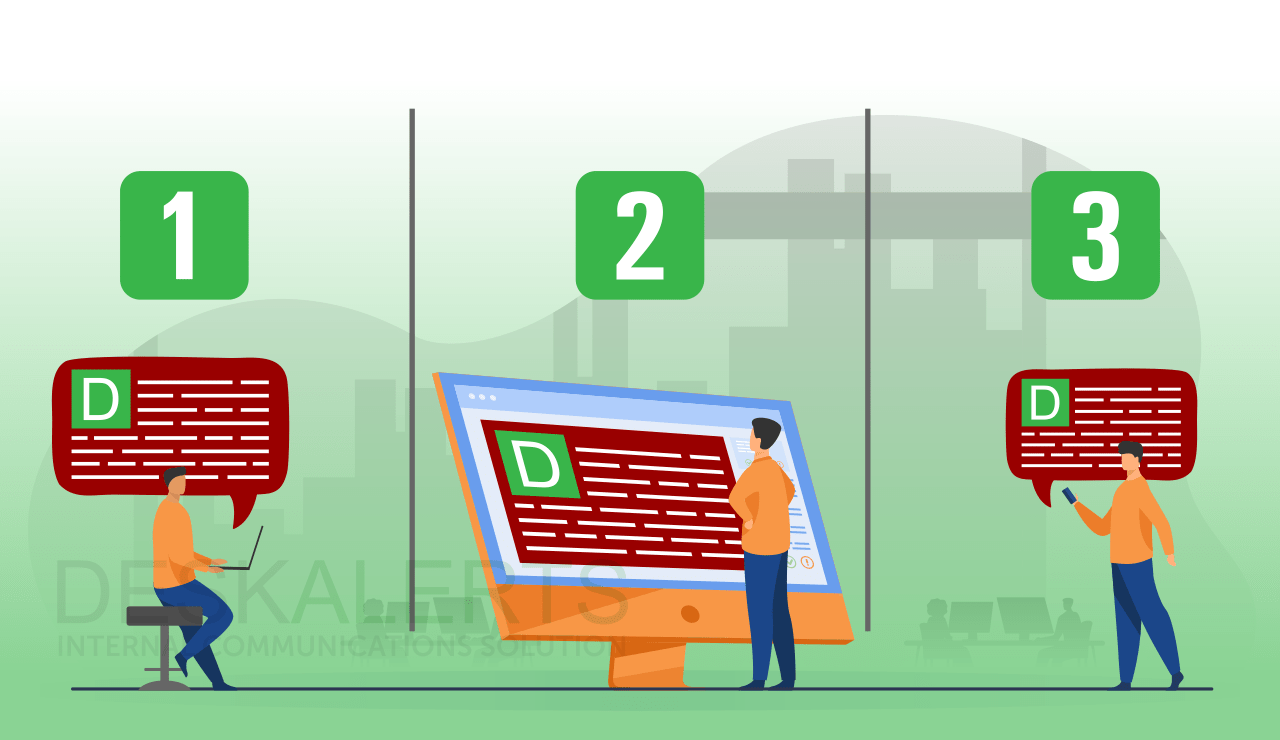
When you’re looking to make improvements to your internal communications, you don’t always have to reinvent the wheel. Looking at what other successful organizations have done in this space and learning from their successes can provide inspiration for your company’s internal communications planning.
While your organization will have its unique issues, you may face similar challenges to other businesses. DeskAlerts publishes case studies examples in corporate communication from its clients in different industries to help others to get insights into how to solve similar issues they may be facing.
What is an internal communication case study?
An internal communication case study looks at the way a company has handled a specific problem or achieved a specific outcome or goal so that people reading it can use it to guide their own approach to solving similar problems.
Workplace case study examples for communication should:
- Explain what the problem was, including the circumstances and any challenges the organization faced
- Explain the solution that was implemented
- Explain about any results achieved.
Organizational communication case study examples
This list of case studies in organizational communication from some of our clients at DeskAlerts has been put together to demonstrate how our internal communications software solution can assist you to overcome common communication challenges, no matter what industry you’re in.
Case study #1. A dedicated emergency communications channel in a crisis
CHU Saint Pierre is a university hospital in Brussels, Belgium. They were looking for a dedicated communications channel for both everyday staff communications, as well as one that they could turn to in the event of an emergency.
The hospital turned to DeskAlerts to ensure that it had a channel that would be able to be used even when other systems like emails and phone were overloaded.
The system was put to the test in 2016 when a series of terrorist attacks rocked Brussels and put an enormous strain on the city’s hospitals, which were operating in a state of emergency. The hospital’s telephone system became overloaded as a result.
DeskAlerts was deployed to inform staff about using SMS messaging to take the strain off internal phone systems, and was then used throughout the crisis to provide critical updates.
Read the case study: Reliable Hospital Emergency Communication During Terrorist Attacks.
Case study #2. A dedicated channel for IT updates
St George’s University of London is a tertiary institution dedicated to medical and health sciences, training, research and education. The university needed to find a dedicated channel to keep people informed about IT updates and to help take pressure off its IT helpdesk.
DeskAlerts was selected for the task as it was found to be easy to set up, implement and deploy as well as being value for money.
The University uses DeskAlerts to send tailored notifications that inform internal clients about updates to IT services. In doing so, it pre-empts unnecessary calls to the IT helpdesk.
Read the case study →
Case study #3. As a way to communicate important information in manufacturing
KRKA is a pharmaceutical company headquartered in Slovenia that sells products to more than 70 countries around the world. The organization had a challenge of needing to communicate to both employees and manufacturing line operators on a range of topics. Not everyone who needed to communicate with accessed information in the same way: some used standalone terminals while others had access to the company intranet.
By implementing DeskAlerts, the company was able to keep people up-to-date on important topics such as system maintenance, system failures, system upgrades and other important events.
The result was that not only were people better informed, but there were various other efficiencies achieved. Staff spent less time having to manually contact people to bring important information to their attention, there were less calls to the tech help desk and staff were able to plan their work around known outages.
Read the case study →
Case study #4. As a way to mitigate significant data and money loss
Weizmann Institute of Science in Israel is one of the world’s largest multidisciplinary research facilities. Many of the systems that are used by researchers at the institute cannot be interrupted otherwise it will result in significant data loss. Certain processes need to be fully completed before any kind of IT maintenance can be performed – and this can take many days and cost thousands of dollars.
The Institute’s IT department found this challenging as it has a lot of systems it needs to maintain, and needed people to be aware of planned maintenance so they didn’t begin running a lengthy process at the wrong time.
The IT department set about looking for a solution that could send information about maintenance, outages, server downtime and other IT announcements that also had a feature where recipients would verify and acknowledge that they had received and read the information sent.
DeskAlerts was chosen as a reliable channel to send these important IT announcements. It has a guaranteed open rate of 100% and a user acknowledgment function. The IT department is now able to do proactive maintenance and create maintenance windows when all users are aware that systems will be unavailable.
Read the case study →
Case study #5. As a way to streamline all corporate communications
NewPage is a specialty paper manufacturer headquartered in the United States of America. The company’s approach to internal communications was ad hoc and not at all streamlined. For example, the company still relied on pagers and the HR department spent a lot of time sending email notifications.
By implementing DeskAlerts, the company has been able to save time and money and better target its communications. DeskAlerts has replaced pagers for emergency communications, and general communication messages can now be sent quickly and easily to targeted employees.
Read the case study →
There are many different ways to use DeskAlerts to solve internal communications challenges. If your issue isn’t featured here, have a look through our other internal communication case study examples to find out how others have solved a similar issue. You can also get in touch with our internal communication experts to find a tailored solution to your internal communication needs.
Frequently asked questions
What is a communication case study?
An internal communications case study is a way of demonstrating the usefulness and value of a particular service by providing the reader with real-life examples.
What are examples of internal communication?
There are several main types of internal communication:
- Communication generated by leadership
- Communication generated by employees
- Peer to peer communications
- Communication about change or campaigns
- Information
- Culture-related communication
- Crisis and emergency communication
What is the importance of communication in case study?
Communicating case studies on communication in the workplace is an important way to engage and inspire an audience while also passing on important information. You can show the value of your work by presenting evidence and telling a story based on facts.
 Caroline Duncan
Caroline Duncan







